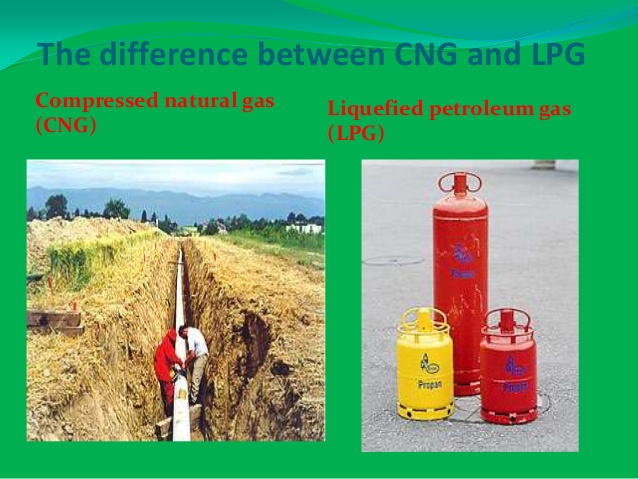What is the difference between liquefied petroleum gas and compressed natural gas?
Compressed natural gas is abbreviated as CNG and liquefied petroleum gas as LPG. These gases have a wider range of applications like in industries, automobiles, and cooking purposes.
The main difference between LPG and CNG is that the former is known as cooking gas whereas the latter for automobile usage.
You May Also Like: Difference between Abiotic and Biotic Factors

Comparison Table (Liquefied Petroleum Gas vs Compressed Natural Gas)
| Basic Terms | Liquefied Petroleum Gas | Compressed Natural Gas |
| Description | It is a kind of natural gas that is flammable and extracted from reservoirs of gas fields. | It is a natural gas that experiences less ignition and extracted from oil wells or coal mines |
| Sources | The reservoir of gas fields | Methane wells, Oil wells, and Coal beds. |
| Properties | Heavier than air and highly flammable | Lighter than air and disperse quickly |
| Constituents | Propane and Butane | Methane |
| Calorific Values | 90 to 95 MJ/m3 | 35 to 40 MJ/m3 |
| Impact on Environment | Releases carbon dioxide which causes the greenhouse effect | Release low quantities of greenhouse gases |
| Risk of Using | Highly flammable and accumulate quickly | Less ignition and dispersible |
| Application | Cooking gas | Automobile fuel and industrial refrigerants |
| Cost | Expensive | Cheaper |
What Is a Liquefied Petroleum Gas (LPG)?
LPG is a liquefied gas and a byproduct obtained during the extraction of crude petroleum. The gas is colorless, odorless, and heavier than air.
Natural gas is highly flammable. It is also a mixture of propane with butane and traces of propylene and butylene.
The most exciting thing about LPG is that it emits less hydrocarbon, nitrogen oxides, and carbon monoxide. It also has high octane rating and increases the longevity of the engine.
The main constituent is methane and traces of ethane, propane, and nitrogen. It is also non-toxic and non-corrosive. It is suitable for cooking gas.
You May Also Enjoy: Difference between BioCarbon and Fossil Carbon
Advantages of Using LPG
- Comparatively affordable than gasoline
- Vehicles experience low maintenance cost
- Exhibit lower emissions to the atmosphere
- Tend to be non-toxic and non-corrosive
- Require little storage space than CNG
Disadvantages of Using LPG
- Lower energy density than gasoline
- Provide less upper cylinder lubrication
- Readily flammable and do not disperse easily
What Is a Compressed Natural Gas (CNG)?
CNG is a natural gas also known as a clean fuel. It comprises compressed methane gas and cheaper than LPG. It is also non-pollutant which implies that it is eco-friendly.
CNG is extracted from coal beds, methane wells, oil wells, and natural gas wells. It is stored in a hard container to maintain the gas state.
It is relatively cheaper when compared to petrol and diesel. Hence, suitable for four-wheel-drive and other heavy-duty engines. It releases little greenhouse gases into the atmosphere.
You May Also Like: Difference between Biodegradable and Non-Biodegradable Substances
Advantages of Using CNG
- No fouling of spark plugs
- The vehicle has lower maintenance costs
- Do not exhibit spillages and evaporation
- Do not contaminate the crankcase oil
- Little emission of greenhouse gases
- Not flammable and dispersible
Disadvantages of Using CNG
- Require large storage space than gasoline
- Limited to specific automobiles
Main Differences between Liquefied Petroleum Gas and Compressed Natural Gas?
- LPG is expensive whereas CNG is affordable
- LPG is obtained from crude petroleum whereas CNG is extracted from coal beds and oil wells.
- LPG is heavier than air whereas CNG is lighter
- LPG is highly flammable while CNG experience less ignition
- LPG contains propane and methane while CNG contain methane only
Similarities between Liquefied Petroleum Gas and Compressed Natural Gas
- Both are natural gases
- Both are stored in hard containers
- Both emit little greenhouse gases
- Both can be transported
- Both can be used domestically and industrially
In Conclusion
LPG was initially known as clean fuel until the arrival of CNG. But CNG is regarded as clean fuel nowadays due to its volatility. CNG is replacing petrol and diesel automobiles.
However, LPG is still being used as cooking gas and its usefulness keeps increasing with time. CNG is only applicable in the automobile industry and other industrial functions.
It would be best to read more on the pros and cons of LPG and CNG. The information will help you make an informed decision before choosing the best option.
More Sources and References
- https://www.originenergy.com.au/blog/what-is-lpg/
- https://en.wikipedia.org/wiki/Compressed_natural_gas
- https://en.wikipedia.org/wiki/Liquefied_petroleum_gas